Multi-Sensor Detection with Particle Swarm Optimization for Time-Frequency Coded Cooperative WSNs Based on MC-CDMA for Underground Coal Mines
Abstract
:1. Introduction
2. System Model
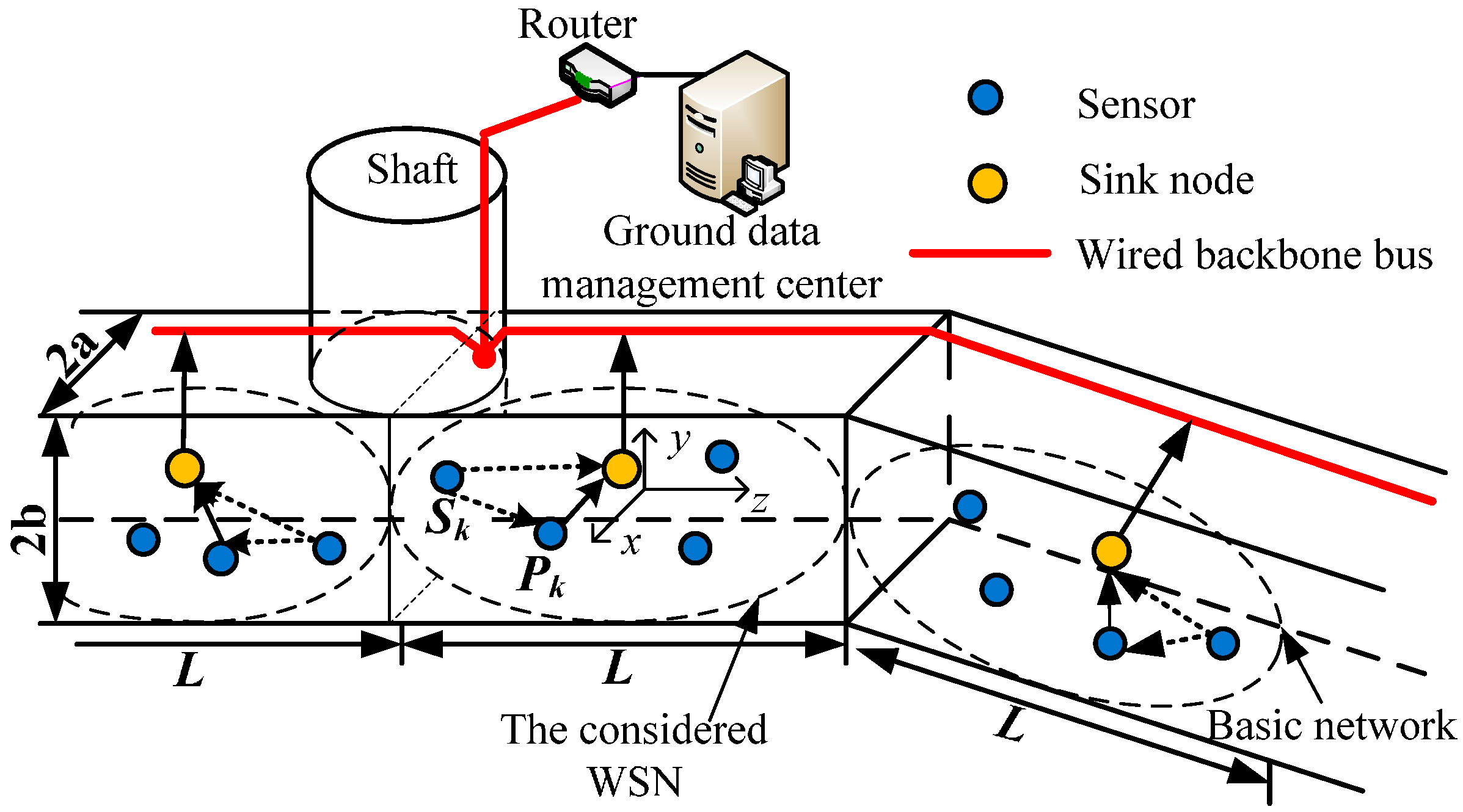
2.1. Coded Cooperative WSN Based on MC-CDMA
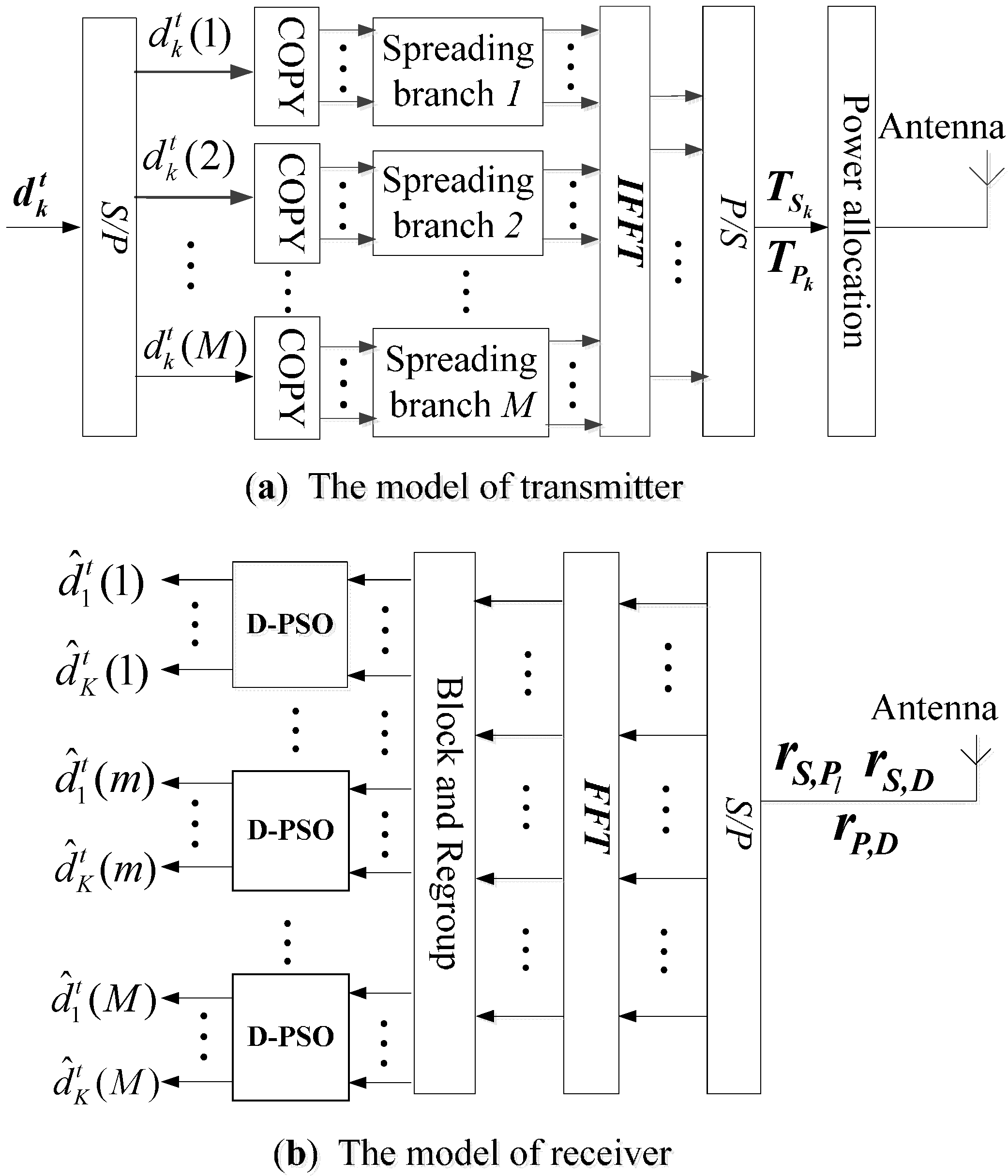
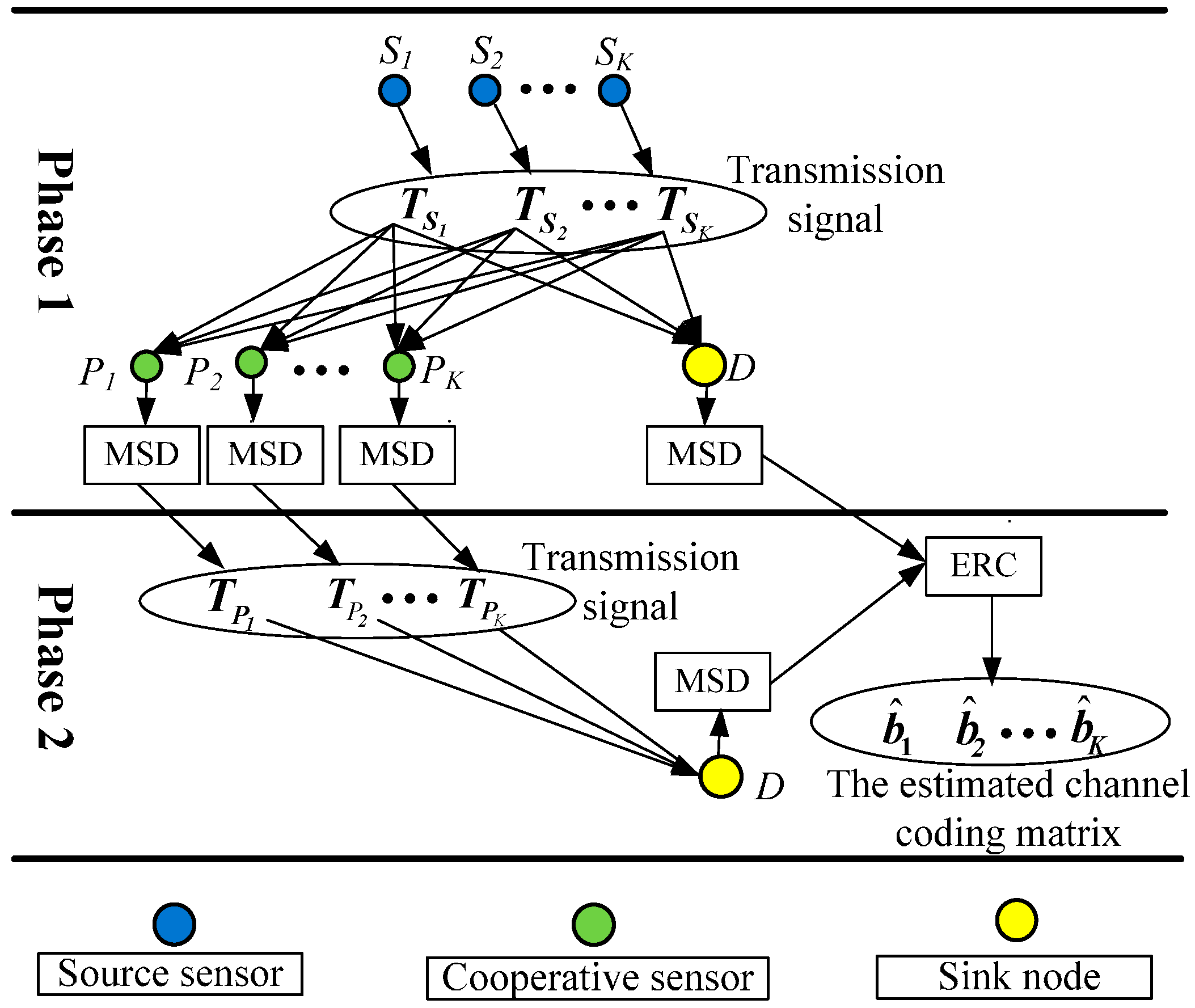
2.2. Channel Model
3. Time-Frequency Coded Cooperative Transmission Based on MC-CDMA and Power Allocation
3.1. Time-Frequency Coded Cooperative Transmission of Source Sensors and Cooperative Sensors in Two Phases
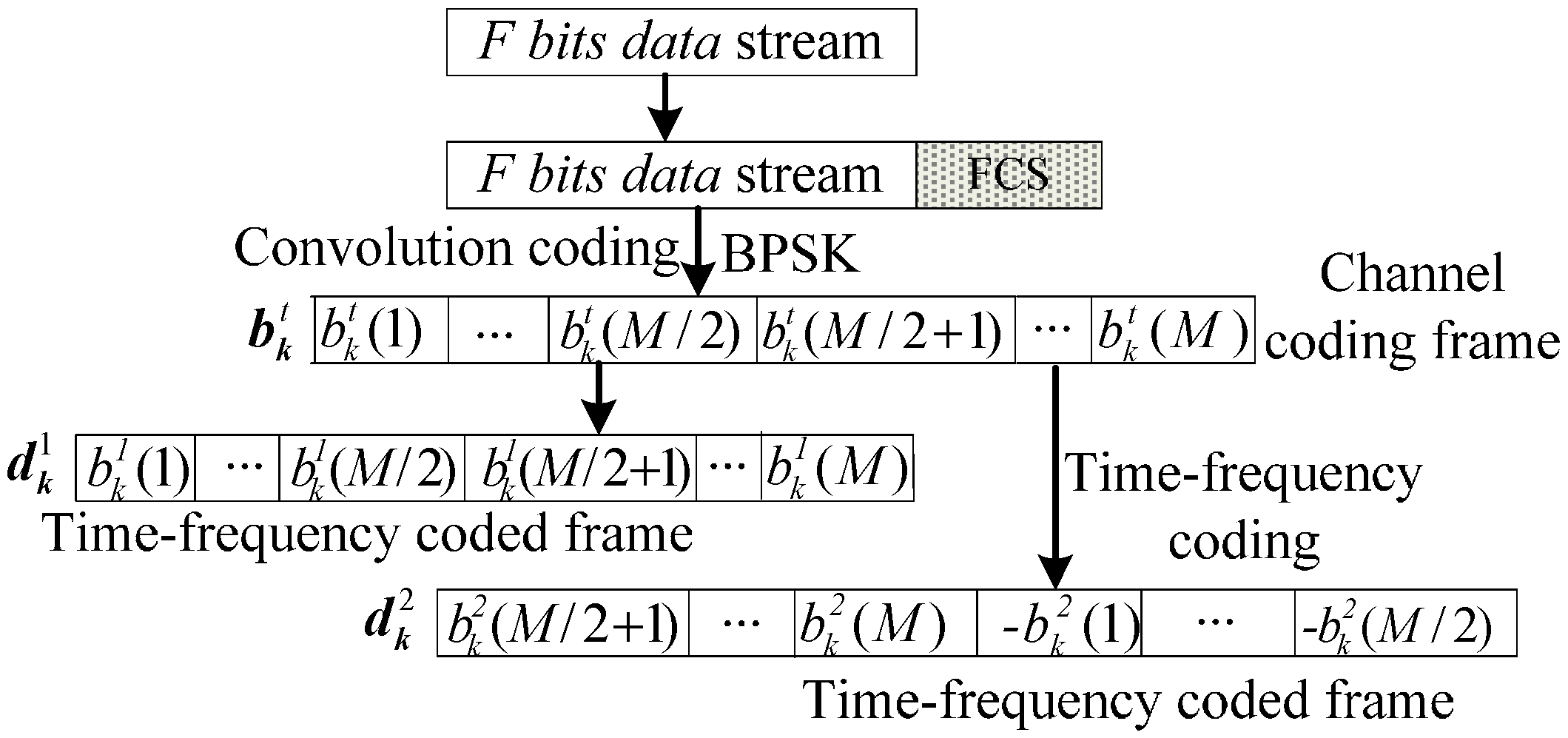
3.1.1. Phase 1
3.1.2. Phase 2
3.2. Power Allocation between Source Sensor and Its Cooperative Sensor
4. Multi-Sensor Detection with Particle Swarm Optimization
4.1. Decorrelation Detection with Particle Swarm Optimization at Cooperative Sensor
- (1)
- Convert the received signal vector into frequency-domain signals through serial-to-parallel converting and Fast Fourier Transform (FFT), then block and regroup to get the detection vector of the m-th symbol;
- (2)
- Apply D-MSD to , and set its output as the initial position of the first particle of D-PSO algorithm, i.e., ;
- (3)
- Update the position and velocity of each particle of the m-th symbol vector according to Equations (18) and (19);
- (4)
- Update the local best position and global best position of the m-th symbol vector with Equations (20) and (21);
- (5)
- Renew the iteration number, i = i + 1 and return to step (3). When the iteration time arrives at Max_dt, D-PSO algorithm outputs the multi-sensor detection result with particle swarm optimization.
4.2. Decorrelating Detection with Particle Swarm Optimization at the Sink Node
4.2.1. Phase 1
4.2.2. Phase 2
4.3. Combining the Detected Results of Two Phases at the Sink Node
5. Results and Discussion
| Parameters | Mark | Value |
|---|---|---|
| Permittivity of vertical wall | 5 | |
| Permittivity of horizontal wall | 5 | |
| Permittivity of the air | 1 | |
| Conductivity of vertical wall | 0.01 | |
| Conductivity of horizontal wall | 0.01 | |
| Conductivity of the air | 0 | |
| Width of the mine tunnel | 2 a | 10 m |
| Height of the mine tunnel | 2 b | 6 m |
| Coverage length of WSN | L | 1200 m |
| Antenna gain of transmitting sensor | Gt | 3 dB |
| Antenna gain of receiving sensor | Gr | 18 dB |
| Permittivity of vacuum space | 8.854 × 10−12 | |
| Permeability of the wall and air | 1.256 × 10−6 |
| Parameters | Mark | Value |
|---|---|---|
| Length of information bit stream | F = Nc/G*R − n | 29 |
| Length of channel coding frame | M = Nc/G*R | 32 |
| Length of CRC check bits (FCS) | n | 3 |
| Rate of convolutional coding | R | 1/2 |
| Modulation type | / | K |
| Parameters | Mark | Value |
|---|---|---|
| Center frequency | f0 | 900 MHz |
| Interval of the subcarriers | ΔF | 15 kHz |
| Spreading code type | / | Walsh Hadamard |
| Parameters | Mark | Value |
|---|---|---|
| Learning factor | c1 | 2 |
| Learning factor | c2 | 2 |
| Inertia weight coefficient | w | 0.99 |
| Total number of particles | Np | 20 |
| Iteration time | Max_dt | 30 |
| Maximum velocity | Vmax | 2 |
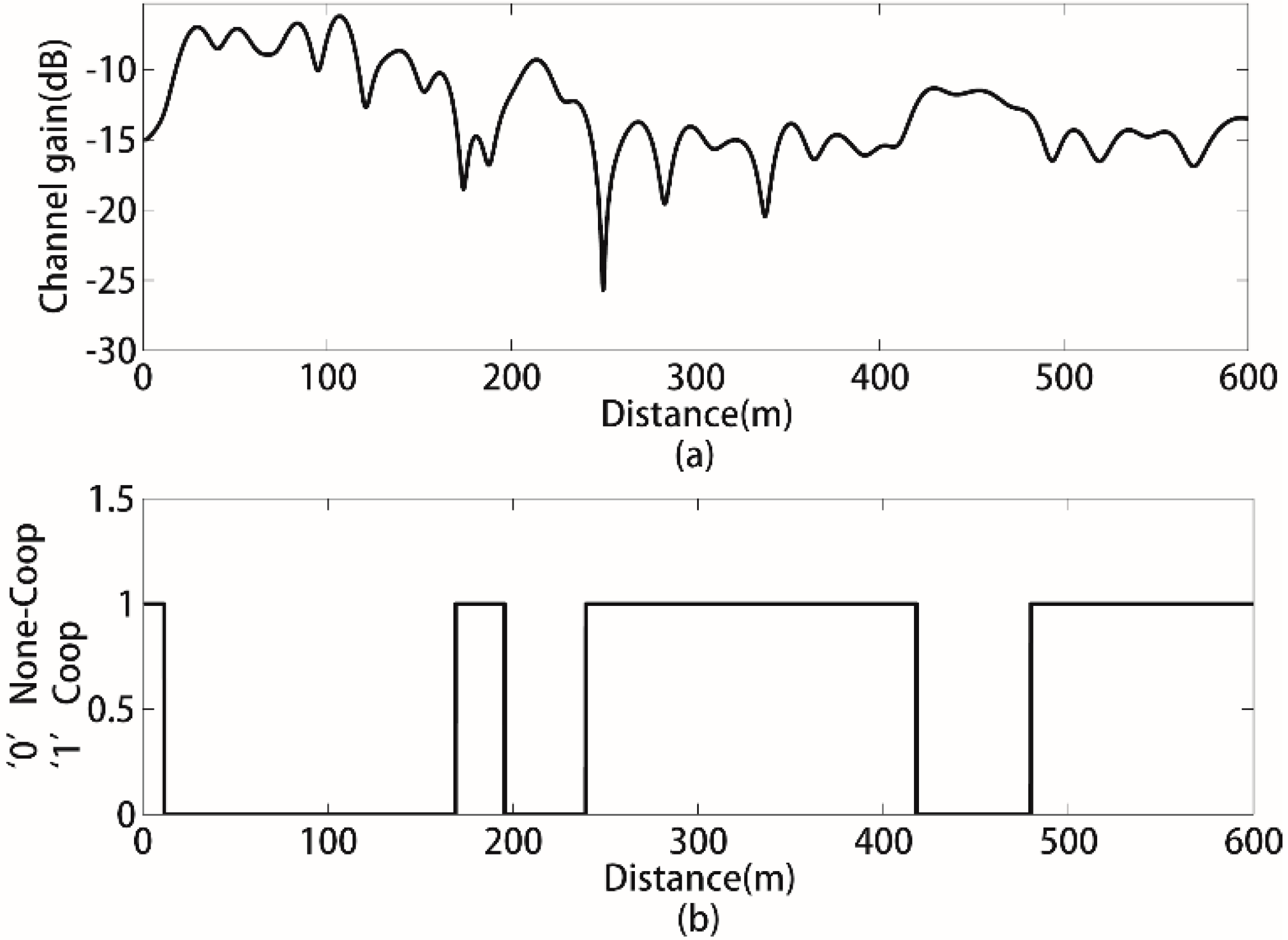
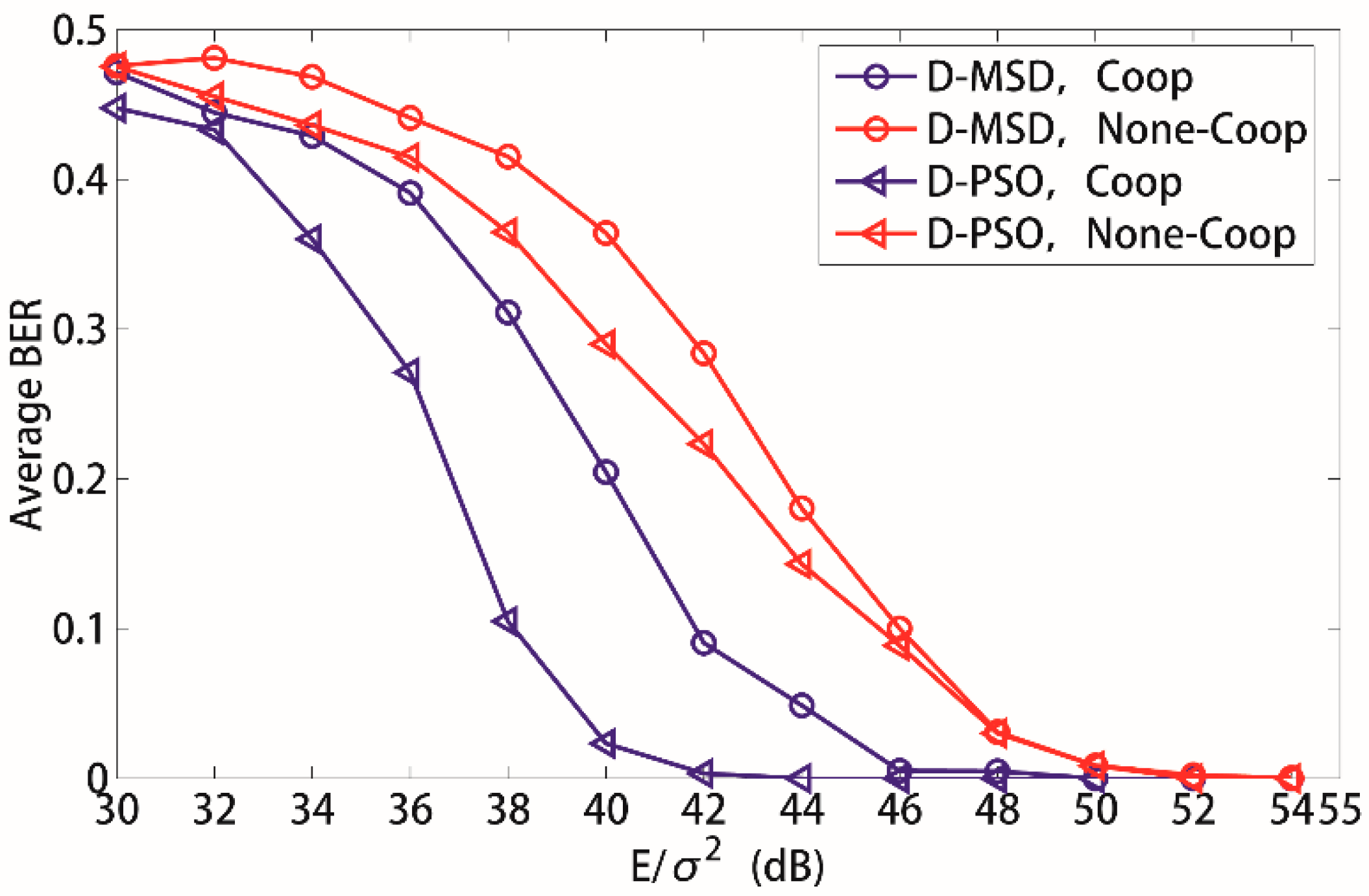

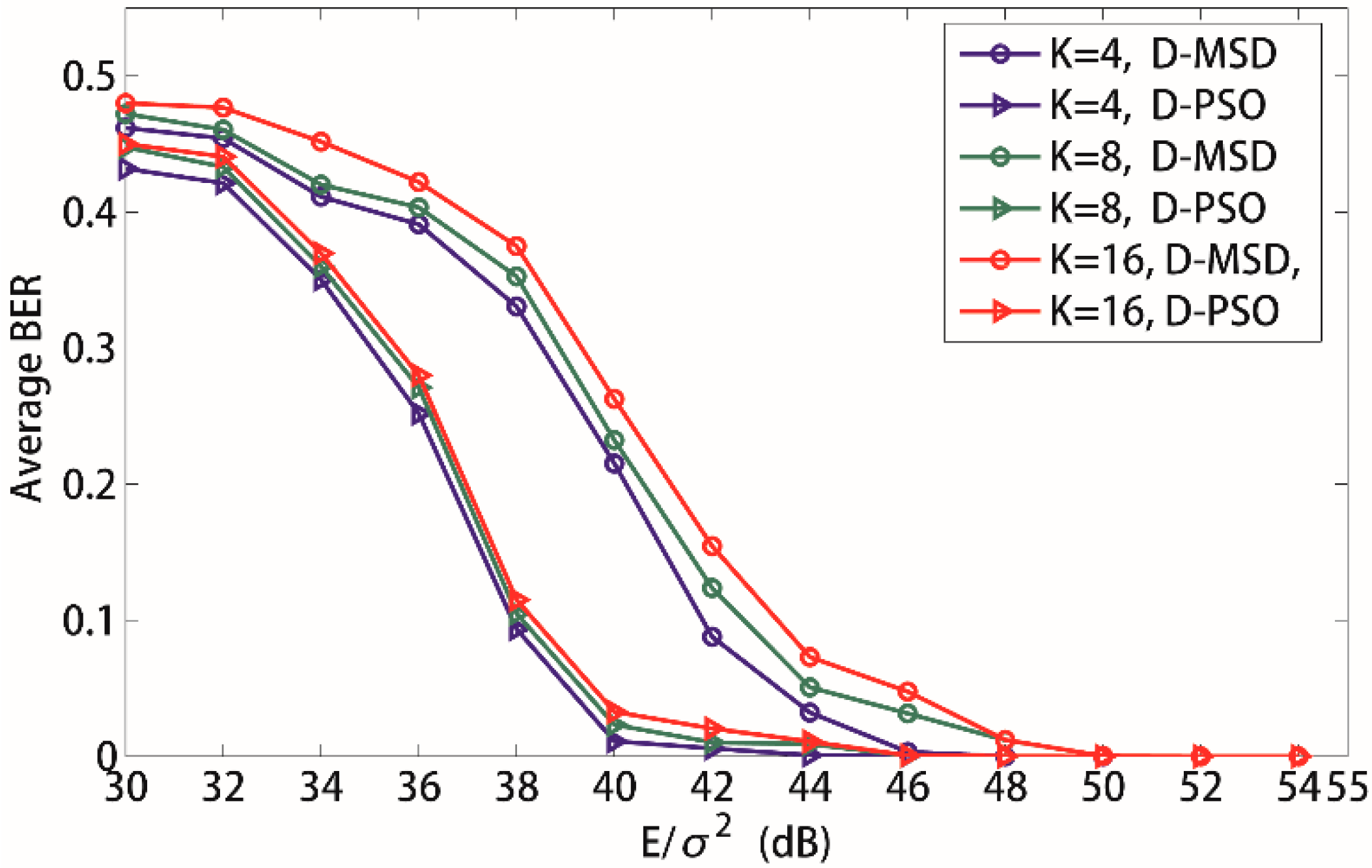
6. Conclusions
- (1)
- Wireless sensor nodes with MC-CDMA wireless transmission can make full use of the open space, time and frequency resources of the underground coal mine to improve the wireless transmission performance.
- (2)
- Wireless sensor nodes with time-frequency coded cooperative wireless transmission can obtain coding gain and spatial diversity gain which will significantly improve the wireless transmission performance of sensors with bad channel conditions.
- (3)
- The MAI among sensors of the time-frequency coded cooperative MC-CDMA WSN can be reduced effectively by adopting the D-PSO algorithm with particle swarm optimization which will also significantly improve the wireless transmission performance of the proposed WSN.
Acknowledgments
Author Contributions
Conflicts of Interest
References
- Zhang, Y.; Yang, W.; Han, D.; Kim, Y.I. An Integrated Environment Monitoring System for Underground Coal Mines—Wireless Sensor Network Subsystem with Multi-Parameter Monitoring. Sensors 2014, 14, 13149–13170. [Google Scholar] [CrossRef] [PubMed]
- Han, G.; Zhang, W.; Zhang, Y.P. An Experiment Study of the Propagation of Radio Waves in a Scaled Model of Long-Wall Coal Mining Tunnels. IEEE Antennas Wirel. Propag. Lett. 2009, 8, 1536–1225. [Google Scholar]
- Li, J.; Whisner, B.; Waynert, J.A. Measurements of Medium-Frequency Propagation Characteristics of a Transmission Line in an Underground Coal Mine. IEEE Trans. Ind. Appl. 2013, 49, 1984–1991. [Google Scholar] [CrossRef]
- Akyildiz, I.F.; Melodia, T.; Chowdhury, K.R. Wireless Multimedia Sensor Networks: Applications and Testbeds. IEEE Proc. 2008, 96, 1588–1605. [Google Scholar]
- Sun, Z.; Akyildiz, I.F.; Hancke, G.P. Dynamic Connectivity in Wireless Underground Sensor Networks. IEEE Commun. Soc. 2011, 10, 4334–4344. [Google Scholar]
- Zhang, Y.P.; Zheng, G.X.; Sheng, J.H. Radio propagation at 900 MHz in underground coal mines. IEEE Trans. Antennas Propag. 2001, 49, 757–762. [Google Scholar] [CrossRef]
- Byun, J.S.; Jeon, B.; Noh, J.; Kim, Y.; Park, S. An intelligent self-adjusting sensor for smart home services based on ZigBee communications. IEEE Trans. Consum. Electron. 2012, 58, 794–802. [Google Scholar] [CrossRef]
- Shrestha, P.L.; Hempel, M.; Sharif, H.; Chen, H.-H. Modeling Latency and Reliability of Hybrid Technology Networking. IEEE Sens. J. 2013, 13, 3616–3624. [Google Scholar] [CrossRef]
- Yang, W.; Cheng, S.; Sun, J. The scheme study of the application of W-CDMA spread spectrum communication in mine mobile communication. J. Coal Sci. Eng. (China) 2000, 6, 64–68. [Google Scholar]
- Buzzi, S.; Saturnino, D. A Game-Theoretic Approach to Energy-Efficient Power Control and Receiver Design in Cognitive CDMA Wireless Networks. IEEE Signal Process. Soc. 2010, 5, 137–150. [Google Scholar] [CrossRef]
- Permuter, H.H.; Shamai, S.; Somekh-Baruch, A. Message and State Cooperation in Multiple Access Channels. IEEE Trans. Inf. Theory 2011, 57, 6379–6396. [Google Scholar] [CrossRef]
- Botsinis, P.; Ng, S.X.; Hanzo, L. Quantum Search Algorithms, Quantum Wireless, and a Low-Complexity Maximum Likelihood Iterative Quantum Multi-User Detector Design. IEEE Access 2013, 1, 94–122. [Google Scholar] [CrossRef]
- Zhang, J.; Chen, S.; Mu, X.; Hanzo, L. Turbo Multi-User Detection for OFDM/SDMA Systems Relying on Differential Evolution Aided Iterative Channel Estimation. IEEE Trans. Commun. 2012, 60, 1621–1633. [Google Scholar] [CrossRef]
- Zhao, N.; Wu, Z.; Zhao, Y.; Quan, T. A Population Declining Mutated Ant Colony Optimization Multiuser Detector for MC-CDMA. IEEE Commun. Lett. 2010, 14, 497–499. [Google Scholar] [CrossRef]
- Guo, D. Performance of multicarrier CDMA in frequency-selective fading via statistical physics. IEEE Inf. Theory Soc. 2006, 52, 1765–1774. [Google Scholar]
- Yang, L.; Soo, K.-K.; Siu, Y.-M.; Chen, R.-S. Hybrid Reduced-Complexity Multiuser Detector for CDMA Communication Systems. IEEE Trans. Veh. Technol. 2008, 57, 414–420. [Google Scholar] [CrossRef]
- Nguyen, G.D.; Kompella, S.; Kam, C. Achievable Throughput under BER Constraints via Transmission Scheduling and Multiuser Detection. IEEE Trans. Wirel. Commun. 2014, 13, 124–131. [Google Scholar] [CrossRef]
- Soo, K.K.; Siu, Y.M.; Chan, W.S. Particle Swarm Optimization Based Multiuser Detector for CDMA Communications. IEEE Veh. Technol. Soc. 2007, 56, 3006–3013. [Google Scholar] [CrossRef]
- Liu, H.; Li, J. A Particle Swarm Optimization-Based Multiuser Detection for Receive-Diversity-Aided. IEEE Signal Process. Lett. 2008, 15, 29–32. [Google Scholar]
- Zhang, J.; Chen, S.; Mu, X.; Hanzo, L. Evolutionary-Algorithm-Assisted Joint Channel Estimation and Turbo Multiuser Detection/Decoding for OFDM/SDMA. IEEE Trans. Veh. Technol. 2014, 63, 1204–1221. [Google Scholar] [CrossRef]
- Lazarescu, M.T. Design of a WSN Platform for Long-Term Environmental Monitoring for IoT Applications. IEEE J. Emerg. Sel. Top. Circuits Syst. 2013, 3, 45–54. [Google Scholar] [CrossRef]
- Zhang, Y.; Sun, L.; Song, H.; Cao, X. Ubiquitous WSN for Healthcare: Recent Advances and Future Prospects. IEEE Internet Things J. 2014, 1, 311–318. [Google Scholar] [CrossRef]
- Yuan, F.; Zhan, Y.; Wang, Y. Data Density Correlation Degree Clustering Method for Data Aggregation in WSN. IEEE Sens. J. 2014, 14, 1089–1098. [Google Scholar] [CrossRef]
- Omri, A.; Hasna, M.O.; Letaief, K.B. Inter-Relay Interference Management Schemes for Wireless Multi-User Decode-and-Forward Relay Networks. IEEE Trans. Wirel. Commun. 2015, 14, 2072–2081. [Google Scholar] [CrossRef]
- Sun, Z.; Akyildiz, I.F. Channel Modeling and Analysis for Wireless Networks in Underground Mines and Road Tunnels. IEEE Trans. Commun. 2010, 58, 1758–1768. [Google Scholar] [CrossRef]
- Huang, W.-J.; Hong, Y.P.; Kuo, C.-C.J. Relay-Assisted Decorrelating Multiuser Detector (RAD-MUD) for Cooperative CDMA Networks. IEEE J. Sel. Areas Commun. 2008, 26, 550–560. [Google Scholar] [CrossRef]
- Peng, R.-M.; Han, Y.; Gao, Q. Distributed Estimation Scheme Based on Cooperative Communication in Wireless Sensor Networks. Wirel. Sens. Syst. 2014, 4, 206–212. [Google Scholar] [CrossRef]
- Sampaio, L.D.H.; Souza, A.R.C.E.; Abrao, T.; Jeszensky, P.J.E. Game Theoretic Energy Efficiency Design in MC-CDMA Cooperative Networks. IEEE Sens. J. 2014, 14, 3065–3075. [Google Scholar]
- Zappone, A.; Buzzi, S.; Jorswieck, E. Energy-Efficient Power Control and Receiver Design in Relay-Assisted DS/CDMA wireless networksvia game theory. IEEE Commun. Lett. 2011, 15, 701–703. [Google Scholar] [CrossRef]
- Yang, H.; Zhang, Y. Analysis of Supercapacitor Energy Loss for Power Management in Environmentally Powered Wireless Sensor Nodes. IEEE Trans. Power Electron. 2013, 28, 5391–5403. [Google Scholar] [CrossRef]
- Hunter, T.; Nosratinia, A. Distributed Protocols for User Cooperation in Multi-User Wireless Networks. In Proceedings of the IEEE Global Telecommunications Conference, Dallas, TX, USA, 29 November–3 December 2004; Volume 6, pp. 3788–3972.
- Yao, W.; Chen, S.; Hanzo, L. Generalized MBER-Based Vector Precoding Design for Multiuser Transmission. IEEE Veh. Technol. Soc. 2011, 60, 739–745. [Google Scholar] [CrossRef]
- Sun, Z.; Akyildiz, I.F. Channel modeling of wireless networks in tunnel. IEEE Trans. Commun. 2008, 58, 1758–1768. [Google Scholar] [CrossRef]
© 2015 by the authors; licensee MDPI, Basel, Switzerland. This article is an open access article distributed under the terms and conditions of the Creative Commons Attribution license (http://creativecommons.org/licenses/by/4.0/).
Share and Cite
Xu, J.; Yang, W.; Zhang, L.; Han, R.; Shao, X. Multi-Sensor Detection with Particle Swarm Optimization for Time-Frequency Coded Cooperative WSNs Based on MC-CDMA for Underground Coal Mines. Sensors 2015, 15, 21134-21152. https://doi.org/10.3390/s150921134
Xu J, Yang W, Zhang L, Han R, Shao X. Multi-Sensor Detection with Particle Swarm Optimization for Time-Frequency Coded Cooperative WSNs Based on MC-CDMA for Underground Coal Mines. Sensors. 2015; 15(9):21134-21152. https://doi.org/10.3390/s150921134
Chicago/Turabian StyleXu, Jingjing, Wei Yang, Linyuan Zhang, Ruisong Han, and Xiaotao Shao. 2015. "Multi-Sensor Detection with Particle Swarm Optimization for Time-Frequency Coded Cooperative WSNs Based on MC-CDMA for Underground Coal Mines" Sensors 15, no. 9: 21134-21152. https://doi.org/10.3390/s150921134
APA StyleXu, J., Yang, W., Zhang, L., Han, R., & Shao, X. (2015). Multi-Sensor Detection with Particle Swarm Optimization for Time-Frequency Coded Cooperative WSNs Based on MC-CDMA for Underground Coal Mines. Sensors, 15(9), 21134-21152. https://doi.org/10.3390/s150921134





